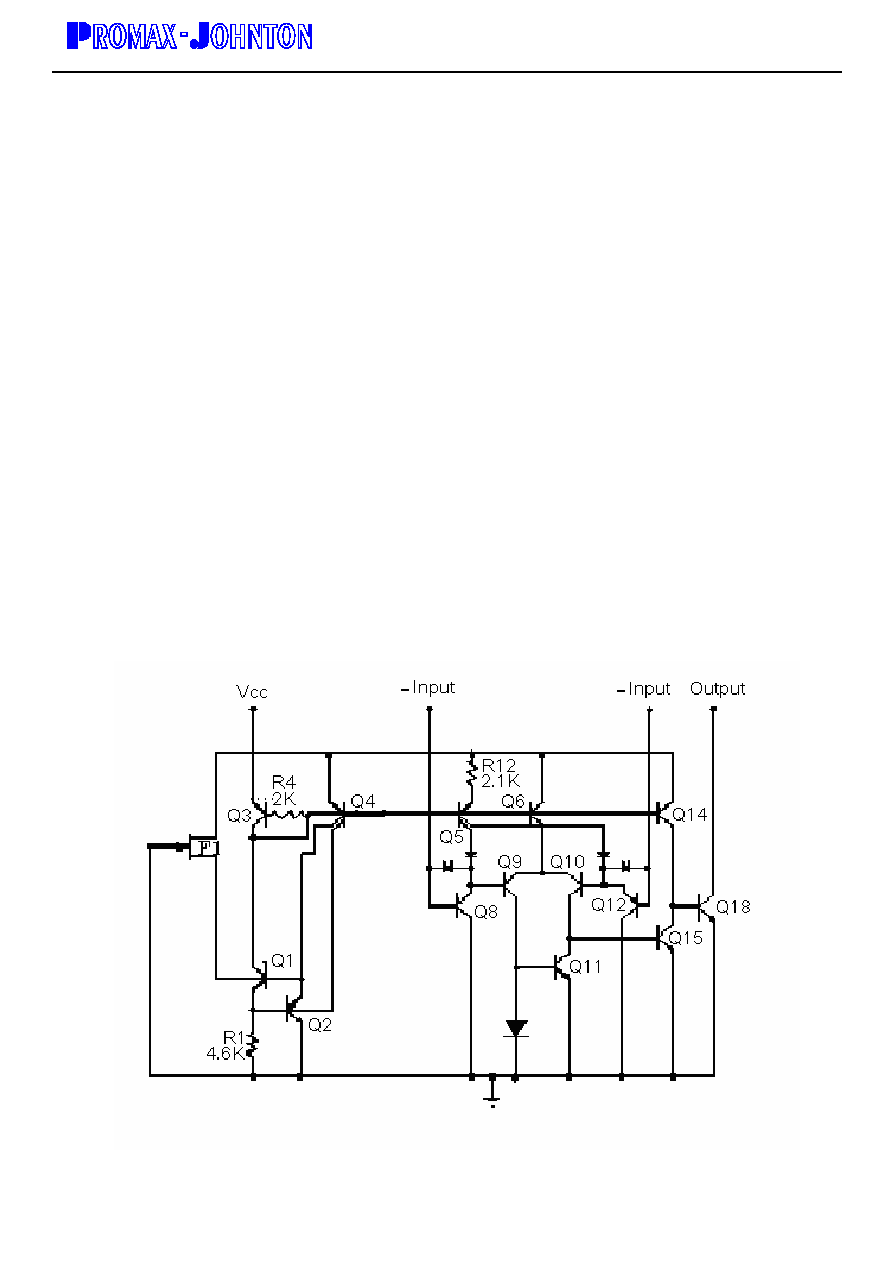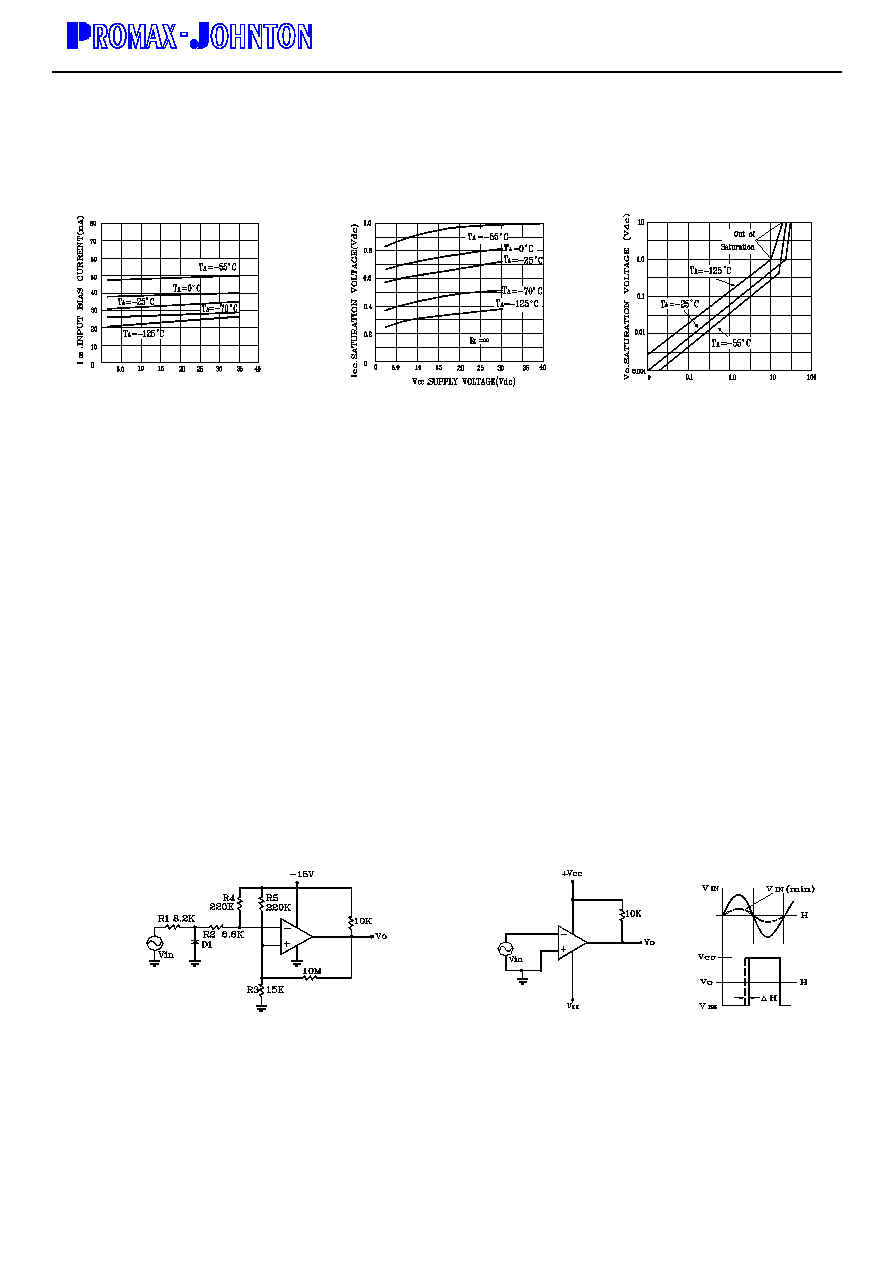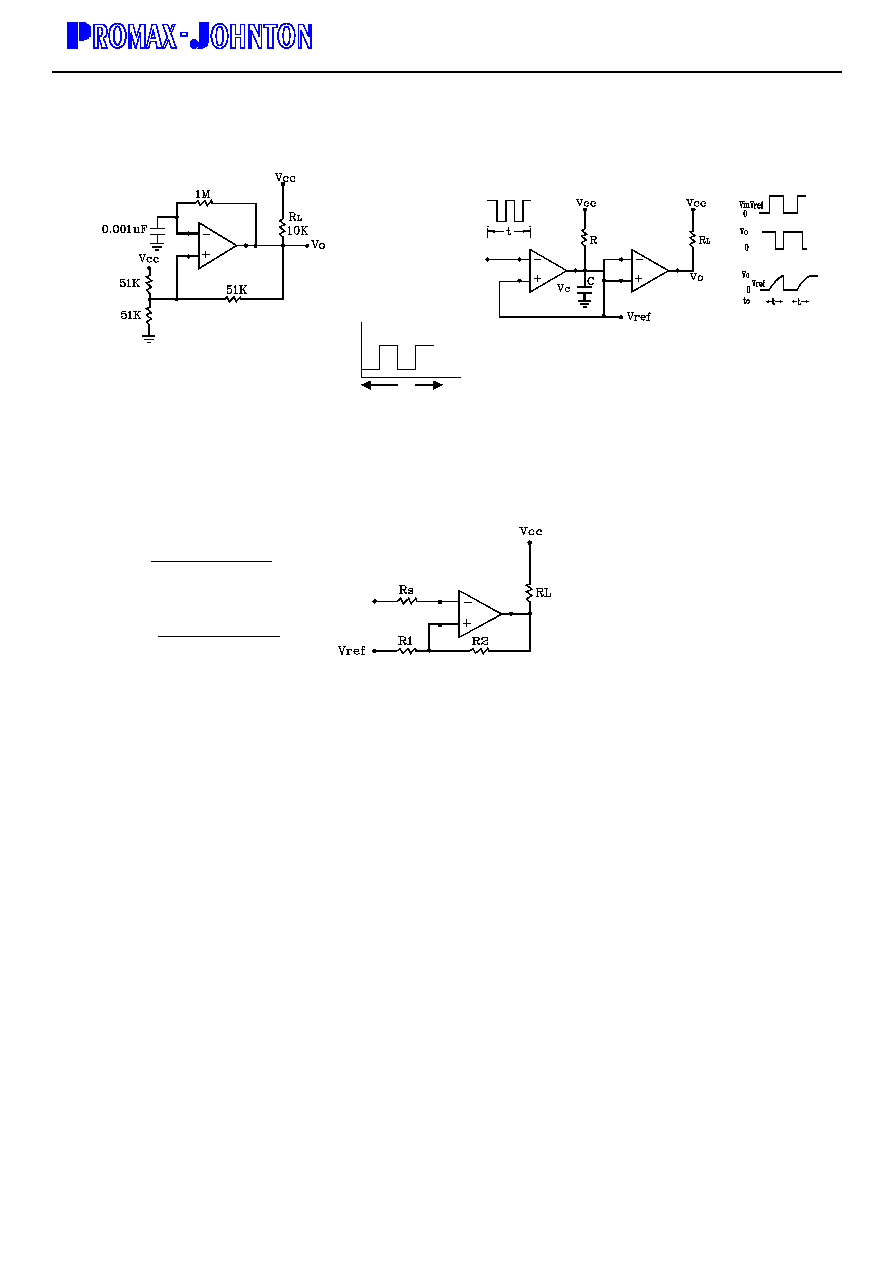 | ÐлекÑÑоннÑй компоненÑ: PJ393CS | СкаÑаÑÑ:  PDF PDF  ZIP ZIP |
þÿ

PJ393
Dual Voltage Comparator
1-6 2001/10 VER.A
DIP-8 SOP-8
Pin : 1. Output 5. Input B
2. Input A 6. Input B
3. Input A 7. Output B
4. Gnd 8. Vcc
he PJ393 is dual independent precision voltage
comparators capable of single- or split-supply
operation.
specifications as low as 2.0 mV make this device an
excellentground level with single-supply operation. Input
offset-voltage selection for many applications in consumer
automotive, and It is designed to permit a common mode
range-to- industrial electronics.
· Output voltage compatible with DTL, ECL, TTL, MOS
and CMOS Logic Levels
· Low input bias current -25 nA
· Low input offset current -5.0 nA
· Low input offset voltage --5.0 mV(max)
· Input common mode range to ground level
· Differential lnput voltage range equal to power supply
voltage
· Very low current drain independent of supply voltage -
0.4 mA
· Wide single-supply range - 2.0 Vdc to 36 Vdc
· Split-supply range - ±1.0 Vdc to ±18 Vdc
Device
Operating Temperature
Package
PJ393CD DIP-8
PJ393CS
-20 +85
SOP-8
Rating Symbol
Value
Unit
Power Supply Voltage
V
CC
+36
or
±18
Vdc
Input Differential Voltage Range
V
IDR
36
Vdc
Input Common Mode Voltage Range
Input Current (2)
(Vin -0.3 Vdc)
V
ICR
I
in
-0.3 to 36
50
Vdc
mA
Output Short Circuit Duration
Output Sink Current (1)
I
SC
I
sink
Continuous
20
mA
Power Dissipation@T
A
=25
Plastic DIP
Derate above 25
P
D
1/R
JA
570
5.7
mW
mW/
Maximum Operating Junction Temperature
PJ393
T
J(max)
T
stg
125
-65 to 150
T
ORDERING INFORMATION
FEATURES
MAXIMUM RATINGS

PJ393
Dual Voltage Comparator
2-6 2001/10 VER.A
(V
CC
= 50Vdc, 0
T
A
70 unless otherwise stated)
PJ393
Characteristics Symbol
Min
Typ
Max
Unit
Input Offset Voltage (3)
T
A
=25
-20
T
A
85
V
IO
--
--
±1.0
--
±5.0
9.0
mV
Input Offset Current
T
A
=25
-20
T
A
85
I
IO
--
--
±5.0
--
±50
±150
nA
Input Offset Current (4)
T
A
=25
-20
T
A
85
I
IB
--
--
25
--
250
400
nA
Input Common Mode Voltage Range (4)
T
A
=25
-20
T
A
85
V
ICR
0
0
--
--
V
CC
-1.5
V
CC
-2.0
Volts
Voltage Gain
R
L
15K , V
CC
= 15 Vdc.
T
A
=25
A
VOL
50
200
--
V/mV
Large Signal Response Time
Vin = TTL Logic Swing.
Vref = 1.4 Vdc
VRL = 5.0 Vdc. RL 5.1 K
T
A
=25
-- -- 300 -- ns
Response Time (6)
VRL = 5.0 Vdc RK = 5.1 K
T
A
=25
t
TLH
--
1.3 --
µs
Input Differentral Voltage (7)
All Vin
Gnd or V-Supply
(if used)
V
ID
-- -- V
CC
V
Output Sink Current
V
in-
1.0 Vdc V
in+
= 0 Vdc
V
O-
15 Vdc T
A
=25
L
sink
60 16 --
mA
Output Saturation Voltage
V
in-
1.0 Vdc. V
in+
= 0
I
sink
4.0 mA, T
A
= 25
-20
T
A
85
V
OL
--
--
150
--
400
700
mV
Output Leakage Current
V
in-
= 0V, V
in+
1.0Vdc
VP = 50 Vdc. T
A
=25
V
in-
= 0V, V
in+
1.0 Vdc
V
O
=30 Vdc -20
T
A
85
I
OL
--
--
0.1
--
--
1000
nA
Supply Current
R
L
=
T
A
=25
R
L
=
V
CC
=30 V
L
CC
--
--
0.4
--
1.0
2.5
mA
ELECTRICAL CHARACTERISTICS

PJ393
Dual Voltage Comparator
3-6 2001/10 VER.A
Notes:
1. The max. Output current may be as high as 20 mA, independent of the magnitude of V
CC
, output short circuits to V
CC
can cause excessive heating and eventual destruction.
2. This magnitude of input current will only occur if the input leads are driven more negative than guound or the negative
supply voltage. This is due to the input PNP collector base junction becoming forward biased acting as an input clamp
diode. There is also a lateral PNP parasitic transistor action on the IC chip. This phenomena can cause the output
voltage of the comparators to go to the V
CC
voltage level (or ground if overdrive is large) during the time the input is
driven negative.This will not destroy the device and normal output states will recover when the inputs become -0.3 V of
ground or negative supply.
3. At output switch point, V
O
= 1.4 Vdc, R
S
= 0
with V
CC
from 5.0 Vdc to 30 Vdc, and over the full input common-mode
4. Due to the PNP transistor inputs, bias current will flow out of the inputs, this current is essentially constant independent
of the output state, therefore, no loading changes will exist on the input lines.
5. Input common mode of either input should not be permitted to go more than 0.3 V negative of ground or minus supply.
The upper limit of common mode range is V
CC
- 1.5 V but either or both inputs can betaken to as high as 30 volts
without damage.
6. Response time is specified with a 100 mV step and 5.0 mV of overdrive. With larger magnitudes of overdrive faster
response times are obtainable.
7. The comparator will inhibit proper output state if one of the inputs become greater than V
CC,
the other input must remain
within the common mode range. The low input state must not be less than -0.3 volts of ground of minus supply.
FIGURE 1- CIRCUIT SCHEMATIC
(Diagram shown is for 1 comparator)

PJ393
Dual Voltage Comparator
4-6 2001/10 VER.A
FIGURE 2 - INPUT BIAS
CURRENT versus
POWER SUPPLY VOLTAGE
FIGURE 4 - POWER SUPPLY
CURRENT versus
POWER SUPPLY VOLTAGE
FIGURE 3 - OUTPUT
SATURATION VOLTAGE
versus OUTPUT SINK CURRENT
APPLICATIONS INFORMATION
This dual comparator feature high gain, wide bandwidth characteristics. This gives the device oscillation
tendencies if the outputs are capactively coupled to the inputs via stray capacitance. This oscillation manifests itself
during output transitions (V
OL
to V
OH
). To alleviate this situation input resistors <10K
should be used. The addition
of positive feedback (<10 mV) is also recommended.
It is good design practice to ground all unused pins.
Differential input voltages may be larger than supply voltage without damaging the comparator's inputs. Voltages
more negative than -0.3 V should not be used.
FIGURE 5 - ZERO CROSSING DETECTOR FIGURE 6 - ZERO CROSSING DETECTOR
( Single Supply ) ( Split Supplies )

PJ393
Dual Voltage Comparator
5-6 2001/10 VER.A
FIGURE 7 - ZERO CROSSING DETECTOR FIGURE 8 - TIME DELAY GENERATOR
Vcc
Vo
0
t
FIGURE 9 - COMPARATOR WITH HYSTERESIS
R
S
= R1 = R2
(Vcc * Vref) * R1
Vth1 = Vref *
R1 * R2 * R
L
(Vref * VoLow) * R1
Vth2 = Vref *
R1 * R2 * R
L




